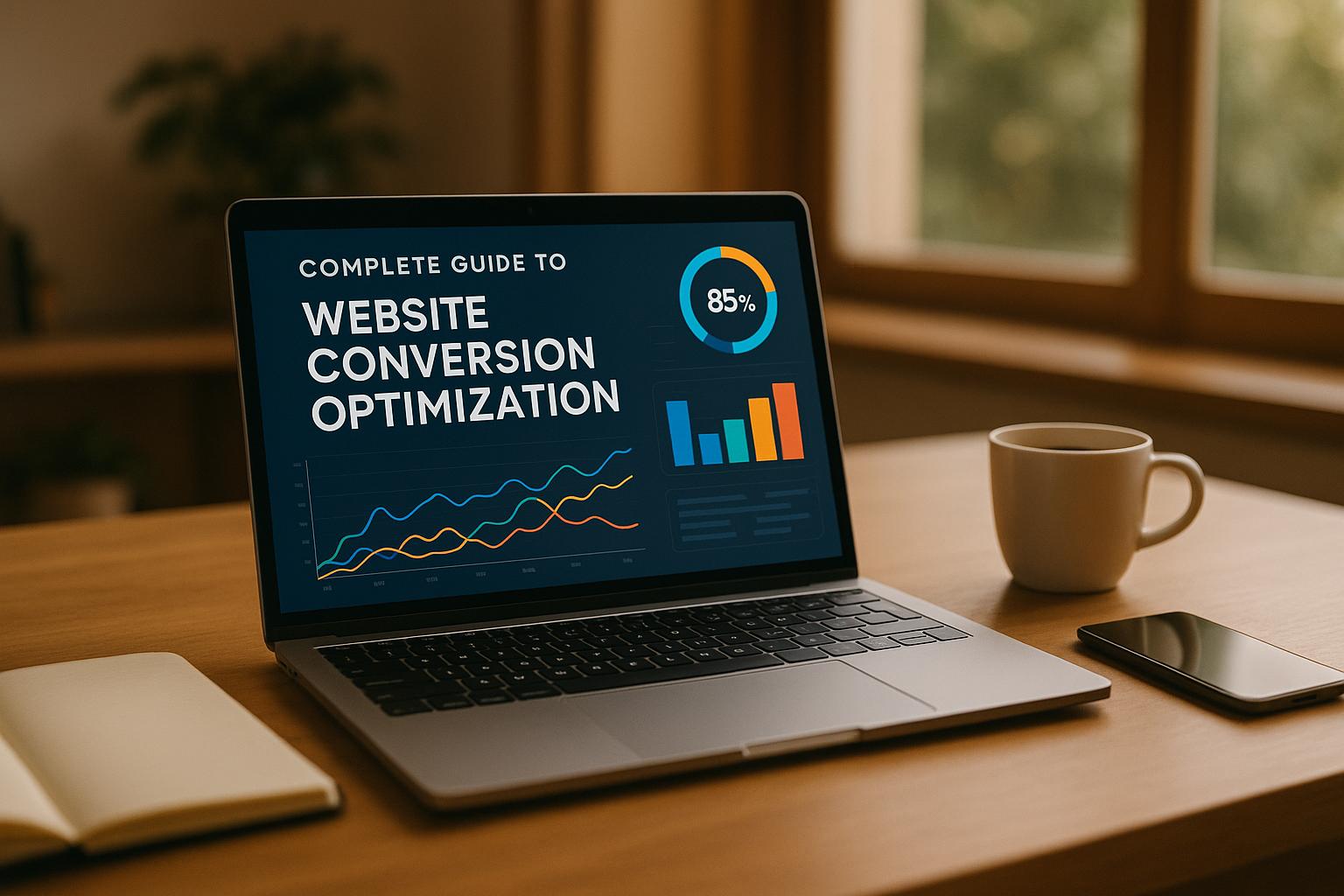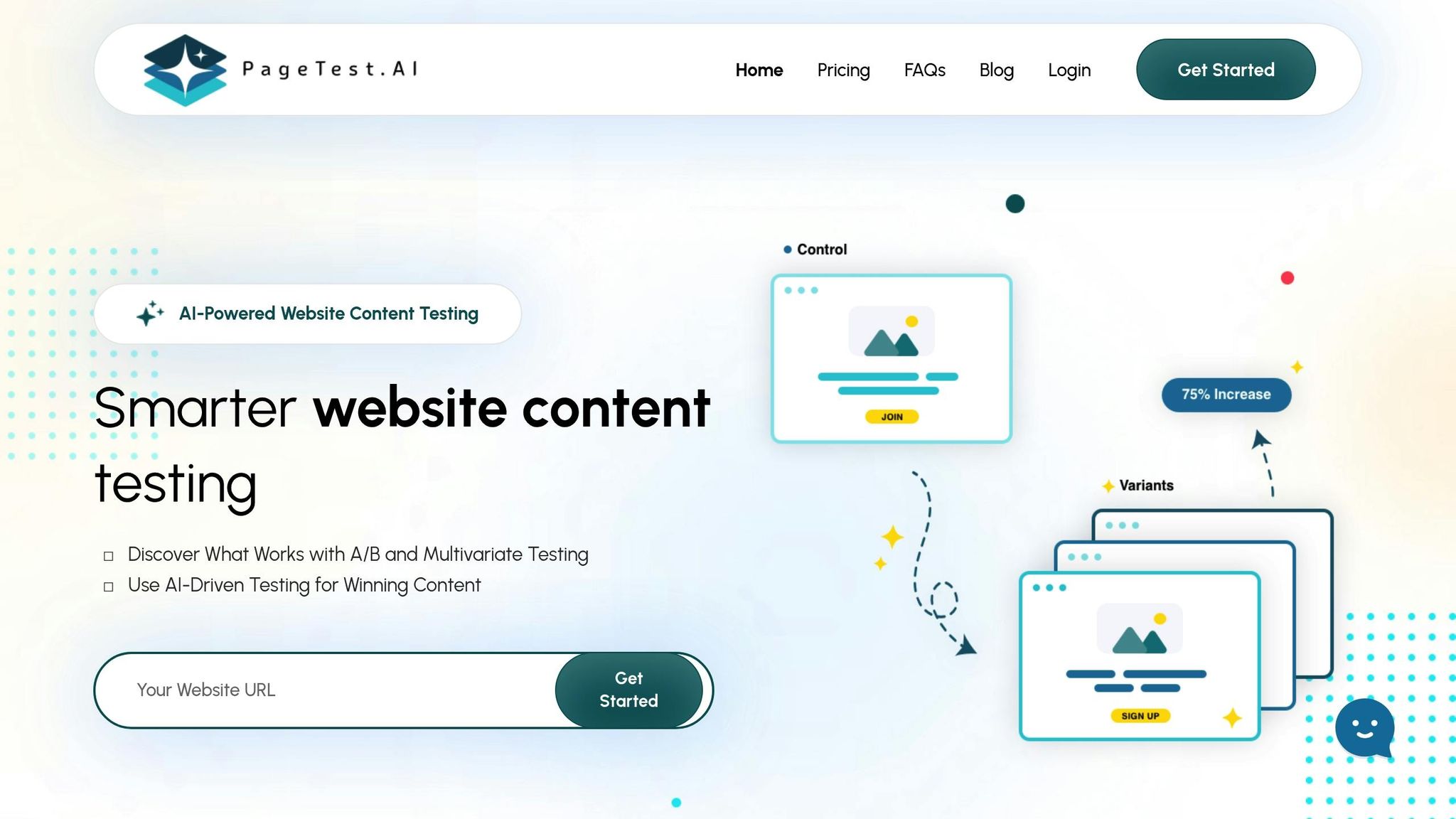

Complete Guide to Website Conversion Optimization

Complete Guide to Website Conversion Optimization
 24-06-2025 (Last modified: 30-06-2025)
24-06-2025 (Last modified: 30-06-2025)
Want to turn more visitors into customers? This guide breaks down how to optimize your website for better conversions using data, testing, and AI tools. Here’s what you’ll learn:
- What is Conversion Rate Optimization (CRO)? Increasing the percentage of visitors who take actions like purchases or sign-ups.
- Why CRO Matters: With acquisition costs rising 20% yearly, making the most of your existing traffic is key.
- Core Strategies:
- A/B Testing: Compare versions of pages to find what works best.
- Personalization: Tailor content to user behavior for higher engagement.
- Behavioral Analytics: Use tools like heatmaps and session recordings to spot issues.
- Key Metrics to Track: Conversion rate, bounce rate, cart abandonment, and more.
- AI’s Role in CRO: Tools like PageTest.AI automate testing, personalization, and optimization for faster results.
Quick Fact: A 0.1-second faster load time can boost conversions by 8.4%. Small tweaks lead to big gains. Ready to dive in? Let’s explore how to optimize your website and grow your business.
Core Principles of Conversion Rate Optimization
What is Conversion Rate Optimization
Conversion Rate Optimization (CRO) focuses on increasing the percentage of website visitors who take a desired action – whether that’s making a purchase, signing up for a newsletter, or clicking on a specific link [11\].
Rather than spending more on attracting new visitors, CRO aims to make the most of the traffic you already have. By improving how effectively your site converts visitors, you can drive greater value without additional advertising costs.
“Conversion rate optimization (CRO) turns your website’s visitors into customers or leads. Instead of spending your precious time and money attracting new traffic, boosting your conversion rate will produce more value from your existing users.” – Michael Keenan, Author, Shopify
The process starts with understanding your current conversion rate and then refining your approach through testing. CRO strategies can lead to higher revenue per visitor, reduced acquisition costs, and more value from your existing audience. A successful CRO plan often involves areas like user research, website analytics, UX design, landing page tweaks, strong copywriting, fast-loading pages, trust-building elements, and mobile optimization.
Once you understand what CRO is, the next step is measuring its effectiveness to guide ongoing improvements.
Key Metrics for Measuring CRO Success
Measuring the success of CRO efforts comes down to tracking the right KPIs. These metrics reveal how well your website or landing page is achieving its goals and provide a way to quantify the impact of your optimization efforts.
“Conversion Rate Optimization KPIs are what separate smart marketing from wishful thinking.” – landingi.com
The conversion rate is the most critical metric, as it directly reflects how many visitors are completing your desired actions. However, it’s essential to look at other metrics too, such as bounce rate, click-through rate (CTR), customer acquisition cost (CAC), and customer lifetime value (CLV).
Here are some key metrics worth tracking:
- Conversion Rate: The percentage of visitors who complete a desired action.
- Bounce Rate: How often visitors leave without engaging further.
- Average Order Value (AOV): The average dollar amount spent per order.
- Customer Lifetime Value (CLV): The total revenue a customer generates over their relationship with your business.
- Cost Per Acquisition (CPA): The cost of acquiring one customer.
For instance, in 2024, the average landing page conversion rate was 5.89%, with top-performing pages hitting 11% or more. Meanwhile, e-commerce sites typically see conversion rates between 2.5% and 3%.
Micro-conversions, like clicking on a specific link or signing up for a free trial, can also offer valuable insights into user behavior.
“Don’t just track KPIs – analyze them. If your bounce rate is high, dig deeper. Is your page too slow? Is the CTA unclear? Numbers tell a story, and it’s your job to interpret it.” – landingi.com
The right metrics depend on your goals. For lead generation, focus on form submissions and cost per lead. In e-commerce, emphasize metrics like cart abandonment rate and checkout completion. For awareness campaigns, track time spent on your site, scroll depth, and returning visitors.
The Role of Data-Driven Decision-Making
Effective CRO relies on data-driven decisions, which replace guesswork with actionable insights based on user behavior and analytics. This approach ensures that your optimization efforts are not only targeted but also scalable over time.
A/B testing is a cornerstone of data-driven CRO. It allows you to test different versions of a webpage to identify which elements work best. For example, in March 2023, Carl Ras improved their conversion rate by 20% through incremental A/B testing, while Quip boosted order conversions by 4.7% by redesigning product display pages.
Analytics play a crucial role in understanding user behavior. Research from Google shows that when page load time increases from 1 to 5 seconds, the likelihood of a bounce jumps by 90%. Websites that load in one second convert 2.5 times better than those that take five seconds. Additionally, personalized user experiences can increase conversion rates by over 200%.
Experimentation and continuous testing are vital for staying competitive, even though only 12% of CRO experiments yield a winning result.
“Experimentation is about learning. The only way your optimization efforts ‘fail’ is if you fail to learn from it.” – Optimizely
To implement a data-driven CRO strategy, use tools like Google Analytics to gather insights. Focus on metrics tied to your goals and analyze user behavior through both quantitative and qualitative methods, such as heatmaps, session recordings, and surveys. Segmenting your data – for example, by traffic source, device type, or new versus returning visitors – can uncover patterns that broader metrics might miss, helping you make smarter optimization choices.
Conversion Rate Optimization Masterclass (Full Course)
Website Conversion Optimization Strategies
Dive into strategies that can transform your website’s performance. These methods focus on converting visitors through targeted testing, personalization, and understanding user behavior.
A/B Testing and Multivariate Testing
A/B testing is a straightforward yet powerful method for improving conversions. It involves comparing two versions of a webpage or app to see which one performs better for a specific goal.
“The concept of A/B testing is simple: show different variations of your website to different people and measure which variation is the most effective at turning them into customers.” – Dan Siroker and Pete Koomen
The impact of A/B testing can be game-changing. For example, Obama’s 2012 re-election campaign saw a 49% boost in donations and added 2.8 million email addresses through testing. Similarly, Bing increased revenue by over $10 million just by tweaking title colors.
Multivariate testing, on the other hand, examines how multiple changes across different page elements interact and affect conversions. While more complex than A/B testing, it can provide deeper insights into how various elements work together.
Here’s how to decide which method to use:
- A/B testing works best when you’re testing a single variable, comparing two very different designs, or working with limited traffic (under 100,000 unique visitors monthly).
- Multivariate testing is ideal for high-traffic pages, testing multiple variables simultaneously, and fine-tuning an already optimized page.
To get the most out of these tests, set clear goals, base your hypotheses on data, and ensure proper tracking. Split traffic randomly, check for statistical significance, and document your findings.
“Assumptions are dangerous when left untested. A/B testing allows you to test those assumptions, and base decisions on evidence not guesswork.” – Leah Boleto, Conversion Optimization Strategist
Once you’ve identified what works, tailor those elements to meet individual user needs through personalization.
Personalization for User Segments
Personalization takes insights from testing and applies them to create tailored experiences for users. By catering to individual preferences and behaviors, personalization can significantly boost engagement and conversions. In fact, 76% of consumers expect personalized content, and 90% of marketers report that it improves profitability.
Brands that embrace personalization often see impressive results. For instance, companies using personalized strategies generate 40% more revenue than those that don’t. Personalized emails are six times more likely to convert, and 63% of marketers report higher conversion rates due to personalization.
Consider these examples:
- Zalando suggests complete outfits based on a customer’s chosen item, leading to 40% larger basket sizes.
- TUI used real-time weather data to customize content recommendations, achieving such success that they reinvested 300% of their campaign budget.
To implement personalization effectively, start by gathering customer data through signup forms, CRM systems, website interactions, and social media. Use this data to segment users based on behavior, demographics, and preferences. AI and machine learning can then help deliver tailored content, emails, and campaigns. For example, Wayfair adjusts its homepage dynamically for logged-in users, showing content based on their browsing and purchase history, while new visitors see general promotions.
Behavioral Analytics and User Insights
Behavioral analytics focuses on tracking how visitors interact with your website to uncover insights about their goals and pain points. This approach helps align your content and calls-to-action with what users are trying to achieve.
Amazon, for example, uses behavioral data to refine its product recommendations, which account for 35% of its revenue. Slack discovered that users who connected at least one integration during their first week were more likely to convert to paid plans, prompting them to redesign their onboarding process to emphasize integrations. Similarly, Booking.com leverages social proof, such as showing how many people are viewing a property, to create urgency and boost hotel bookings.
Tools like heatmaps can visualize user behavior, showing where visitors focus their attention and revealing areas for improvement. For instance, Paltalk used heatmaps to identify issues in its virtual gifts menu, leading to a redesign that increased conversions by 11.32%. Session recordings can also highlight where users face friction, such as abandoned carts or confusing navigation, allowing you to make targeted adjustments.
Even small changes can yield big results. Cocohanee, an eCommerce site, boosted transactions by 40% after adding its unique selling proposition to product pages and updating its menu. By tracking metrics like bounce rates, time on site, and conversion rates, you can continuously refine your website. Pair these insights with A/B tests to validate improvements.
Behavioral analytics not only helps you understand your audience better but also enables you to deliver a more seamless and engaging user experience.
sbb-itb-6e49fcd
AI-Powered Tools for Conversion Rate Optimization
Artificial intelligence is changing the game for businesses looking to improve their conversion rates. With AI-powered tools, companies can analyze user behavior in real time, create content variations automatically, and deliver personalized experiences that lead to measurable results.
The adoption of AI in conversion rate optimization (CRO) is growing fast. According to a McKinsey study, 35% of companies now use AI in marketing and sales, with CRO being one of the main ways they enhance customer journeys and boost ROI. Similarly, Salesforce‘s State of Marketing report highlights that 68% of top-performing marketers rely on AI to enhance customer experiences through personalization and predictive targeting.
“AI conversion rate optimization is no longer a luxury – it’s a competitive advantage.” – Tope Longe, Growth Marketing Manager, UXCam
Unlike traditional methods like manual A/B testing, AI-driven CRO uses advanced algorithms to personalize and adapt user experiences in real time. This approach enables multivariate testing and quickly reallocates traffic to the best-performing variations, making the process faster and more efficient.
These advancements pave the way for tools like PageTest.AI, which aim to make CRO accessible to businesses of all sizes.
Overview of PageTest.AI

PageTest.AI is a platform built to streamline conversion rate optimization by leveraging artificial intelligence. It eliminates the need for coding and provides advanced testing features that were once limited to larger organizations. The platform automatically generates multiple content variations based on proven strategies, cutting down on brainstorming time and allowing businesses to focus on testing effective messaging.
PageTest.AI integrates with popular website platforms such as WordPress, Wix, Shopify, and custom-built sites. A Chrome extension makes it easy to select content with a simple point-and-click interface, while the AI tracks key metrics like clicks, engagement, time on page, and scroll depth. Real-time analytics provide insights into visitor behavior and continuously optimize content delivery. The platform also simplifies multivariate testing, automating what used to be a complex and resource-heavy process.
PageTest.AI’s pricing structure reflects its flexibility, offering plans suited to businesses of all sizes.
Pricing and Features
- Free Trial: Includes 10,000 test impressions, up to 5 pages, and 5 tests for one website.
- Startup Plan: At $10 per month, this plan increases limits for small businesses.
- Enterprise Plan: For $50 per month, it offers 100,000 test impressions and supports up to 10 websites.
- Agency Plan: Priced at $200 per month, this tier provides 1 million test impressions, unlimited pages, and tests across up to 100 websites.
Benefits of AI in CRO
AI-powered tools like PageTest.AI bring speed, precision, and scalability to conversion optimization. These tools automate experiments, analyze results, and implement changes quickly, significantly reducing the time required for testing. For example, a study by the Federal Reserve Bank of St. Louis found that generative AI can save workers 1 to 4 hours per week, which can translate into faster CRO iterations.
AI also enhances accuracy by eliminating cognitive biases that often affect manual testing decisions. It continuously monitors user behavior, adapts to trends, and ensures optimization efforts stay relevant, even as user preferences evolve.
Personalization is where AI-driven CRO truly shines. By analyzing individual user data, AI customizes content, offers, and calls-to-action to match each visitor’s preferences. This level of personalization is now attainable for businesses of any size, without requiring a large analytics team. McKinsey research shows that personalization can boost revenue by 5% to 15%, and Segment’s 2024 State of Personalization report reveals that 89% of business leaders see personalization as critical to their success.
To fully leverage AI in CRO, consider these strategies:
- Use behavioral analytics tools to feed AI with user interaction data.
- Automate testing to run experiments efficiently.
- Segment audiences based on behavior for more targeted optimizations.
- Implement insights and updates automatically to keep improving user experience and performance.
Implementing and Measuring CRO Success
To successfully implement conversion rate optimization (CRO), you need a clear, data-driven strategy that turns insights into actionable steps. With most websites converting only 2–3% of their traffic, the potential for improvement is substantial when the right approach is applied.
Step-by-Step CRO Implementation
Effective CRO begins with setting SMART goals – objectives that are Specific, Measurable, Achievable, Relevant, and Time-bound. Businesses with clearly defined goals are 10 times more likely to improve their conversion rates. For instance, instead of vaguely aiming to “increase conversions”, set precise targets like “boost email sign-ups by 25% within three months” or “increase checkout completions by 15% over the next quarter.”
Start with research. Use analytics, heatmaps, session recordings, and surveys to identify where users drop off. As Josh Gallant, Founder of Backstage SEO, puts it:
“Efficient optimization begins with ensuring the right tools are in place at the beginning. You need to ensure you have analytics tracking and reporting in place, because poor data and an inability to measure and test changes means all optimization is guesswork”.
Once you have the data, form a hypothesis based on it. Clearly outline the proposed change, why it’s needed, and the expected outcome. For example: “Changing the CTA button text from ‘Submit’ to ‘Get My Free Quote’ will increase form completions by 20% because it emphasizes value.”
Testing is the next step. A/B testing is a great way to assess single changes by comparing two versions of a page or element. For example, Orah, a software company, increased demo requests by 63.27% by reorganizing homepage sections to improve information accessibility. For more complex changes, multivariate testing can help. Hyundai.io, for instance, increased click-through rates by 208% and leads by 60% by testing combinations of text, CTA buttons, and image sizes on its landing pages.
Don’t overlook mobile optimization. Nearly half of users expect a site to load in two seconds or less, and every additional second can reduce conversions by 7%. Shirtinator demonstrated the importance of this by redirecting tablet users to their desktop site, which resulted in a 72% revenue increase and a 32% boost in completed orders.
Finally, use the results of your tests to refine your strategy and improve further.
Interpreting and Acting on Test Results
After running your tests, the real work begins: interpreting the results and turning them into actionable insights. This involves more than just picking a “winner” – you need to rely on statistical significance to ensure the results aren’t due to random chance.
Data-driven organizations are 23 times more likely to acquire customers and 19 times more likely to be profitable. Focus on primary metrics like conversion rates, bounce rates, and time on page, but also pay attention to secondary data, which can reveal unexpected insights.
Combine quantitative data with qualitative observations. For example, Elegant Steps, a UK-based wedding shoe retailer, discovered their mobile conversion rate (0.6%) was far behind their desktop rate (2%). By using heatmaps, they identified issues with the “Shop by Brand” section and the visibility of free shipping offers. Fixing these problems increased mobile conversions by 200% and cut bounce rates nearly in half. Similarly, Lyyti, a Finnish event management software provider, used heatmaps to uncover confusion between its pricing and features pages. A redesign resulted in a 93.71% increase in clicks to its lead generation page.
These insights ensure that your CRO efforts are consistently guided by real data, enabling continuous improvement.
Best Practices for Continuous Improvement
CRO isn’t a one-and-done task – it’s an ongoing cycle of testing, analyzing, and refining. Aim for steady progress; a well-executed CRO program can yield a 30% annual increase in conversions. Structured strategies typically deliver similar results.
Commit resources to regular testing. Develop a conversion roadmap to plan and prioritize experiments across key website pages. Re-test winning variations periodically to confirm that improvements are sustainable and not just statistical flukes.
Focus on optimizing the bottom of the funnel, where changes often have the biggest impact. For example, Expedia increased annual profits by $12 million simply by removing an unnecessary form field.
Every test should have a solid, data-backed hypothesis. Random changes rarely lead to meaningful results. As Alexander Svensson from SiteTuners explains:
“The goal of CRO audits is to create a seamless experience for your customers, ensuring that any tweaks you make enhance their journey rather than just pushing for conversions with no real improvement in their experience”.
Don’t forget about SEO. Companies that invest in SEO are 53% more likely to see better conversion rates. Time Doctor, for example, achieved significant growth by improving website speed, mobile-friendliness, and keyword optimization, which led to increased organic traffic and trial sign-ups, contributing to seven-figure revenue gains.
Using tools like PageTest.AI can help guide your optimization efforts with real-time analytics. Documenting your findings creates a knowledge base that informs future decisions and avoids repeating past mistakes.
As Josh Gallant emphasizes:
“CRO is a way of combining different elements to produce a repeatable system of continual testing and analysis, where you’re constantly benchmarking your performance”.
Conclusion and Key Takeaways
Optimizing website conversions has become a core strategy for staying competitive, and AI is at the heart of this transformation. With its ability to deliver faster and more accurate results, AI is reshaping how businesses approach conversion rate optimization (CRO).
Research highlights that AI-powered CRO not only boosts conversion rates but also enables rapid experimentation, real-time personalization, and automated testing – capabilities that traditional methods struggle to match .
“AI conversion rate optimization is no longer a luxury – it’s a competitive advantage.”
AI’s edge lies in its ability to quickly analyze user behavior, automate testing processes, and provide personalized experiences at scale. This leads to quicker experimentation cycles, better ROI, and greater scalability. It also levels the playing field, making advanced CRO strategies accessible to businesses of all sizes.
Take, for instance, PageTest.AI. This no-code AI tool allows businesses to optimize their websites easily with user-friendly interfaces and simple Chrome extensions, proving that you don’t need a technical background to benefit from AI-driven CRO.
At its core, successful CRO depends on data-driven decisions. Combining quantitative metrics with qualitative insights – understanding not just what users do, but why they do it – is key. And it’s important to remember that CRO isn’t a one-and-done task; it’s a continuous process. As Kieran Flanagan, SVP of Marketing at HubSpot, puts it:
“Personalization of messaging – and at scale – is a great AI CRO application… Whenever you’re able to message customers in a personal way always works really well.”
For businesses ready to act, the path forward is clear. Start by using behavioral analytics tools, adopt AI-powered platforms for automated multivariate testing, and segment audiences to create tailored experiences. The technology is here, and it’s more accessible than ever. The real question is: will you embrace it before your competitors do?
FAQs
What’s the best way to choose CRO strategies that align with my business goals?
To select the most effective conversion rate optimization (CRO) strategies for your business, start by setting clear, actionable goals. These goals should be specific, measurable, and tied directly to your broader business objectives. For instance, you might aim to boost sales by 15% within the next quarter or increase lead generation by 20%.
Once your goals are in place, take a deep dive into your audience’s behavior. Understand what they value, what frustrates them, and what drives their decisions. This data will guide your hypotheses for testing strategies like A/B testing, personalized experiences, or behavioral analytics. Prioritize optimizing pages that make the biggest impact – think high-traffic areas like your homepage, key product pages, or the checkout process.
As you implement these strategies, monitor progress using key performance indicators (KPIs). Use insights from the data to tweak and refine your approach. By consistently testing and adjusting, you’ll see steady improvements in how your website performs and connects with your audience.
How can AI improve website conversions, and what are the best ways for small businesses to use it effectively?
AI plays a powerful role in website conversion optimization by diving into user behavior, spotting patterns, and creating tailored experiences. It enables businesses to tweak and test website elements quickly, leading to better user engagement and increased conversions.
For small businesses, AI tools can be a game-changer. They automate tasks like A/B testing, content adjustments, and analyzing user interactions. These tools take the guesswork out of improving a website, making it easier for businesses to enhance their online presence without needing advanced technical skills. By tapping into AI, small businesses can make smarter decisions, stretch their resources further, and see real, measurable outcomes.
What are the best practices for improving website conversion rates, and how often should I update my strategies?
To keep improving your website’s conversion rates, it’s crucial to dive into user behavior using both qualitative and quantitative research. This means collecting customer feedback, studying interaction data, and keeping an eye on trends. These insights can reveal exactly where your website might need adjustments. Focus on methods like A/B testing, personalization, and behavioral analytics to fine-tune the user experience and achieve better outcomes.
Make it a habit to revisit your conversion rate optimization (CRO) strategies at least once every quarter. That said, if you notice shifts in how users interact with your site, changes to its features, or new market trends, don’t hesitate to review and update your approach more often to stay effective.
Related posts
say hello to easy Content Testing
try PageTest.AI tool for free
Start making the most of your websites traffic and optimize your content and CTAs.
Related Posts

 10-11-2025
10-11-2025
 Ian Naylor
Ian Naylor
How Multivariate Testing Fails Without Proper Planning
Effective multivariate testing requires clear goals, focused variables, and adequate data. Poor planning can lead to wasted resources and unreliable results.

 08-11-2025
08-11-2025
 Ian Naylor
Ian Naylor
AI in Behavioral Segmentation: 3 Success Stories
Explore how AI-driven behavioral segmentation is reshaping customer engagement, with success stories from various industries showcasing measurable results.

 06-11-2025
06-11-2025
 Ian Naylor
Ian Naylor
How Predictive Segmentation Improves Conversions
Learn how predictive segmentation can significantly enhance conversion rates and optimize marketing strategies through data-driven insights.
